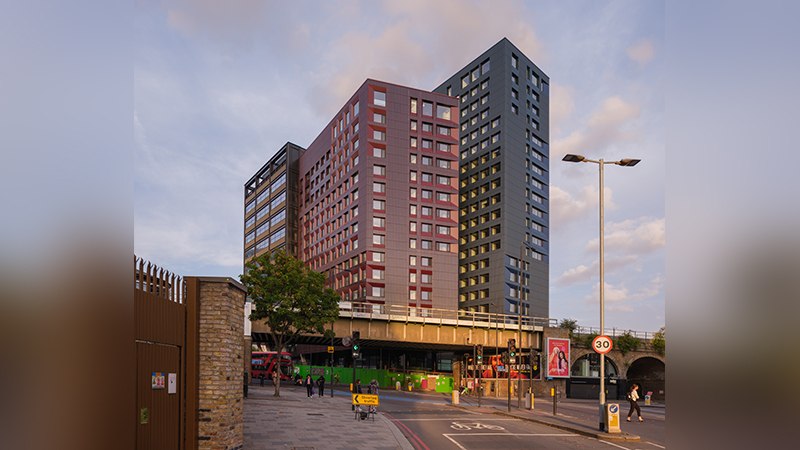Landlord and Tenant Act 1954, Part II, section 30(1)(g) — New tenancy of multi-storey car park sought by tenants but opposed by landlords on the ground that they intended to occupy the premises for purposes of a business to be carried on by them therein — Landlords were the lessees of a large development of retail shops, banks and leisure facilities for which the multi-storey car park provided the parking accommodation — Landlords claimed that it would be advantageous for them to operate the car park themselves — The question in this preliminary issue was whether they could establish a firm and settled intention, as explained in such cases as Cunliffe v Goodman, to occupy the premises for the purposes of their business — Landlords submitted evidence from the minutes of their board meetings, from quotations for parking control equipment obtained from a supplier, and by an affidavit sworn by their property director, to show a present settled intention — Although the material was criticised by the tenants on various grounds, the judge held that the landlords’ firm and settled intention had been established and granted a declaration accordingly — The tenants’ summons in the preliminary issue was dismissed.
This was a
preliminary issue, tried in accordance with a master’s order, in proceedings
under Part II of the Landlord and Tenant Act 1954 for a new tenancy. The
plaintiff tenants, Europark (Midlands) Ltd, a subsidiary of National Car Parks,
sought a new tenancy of a multi-storey car park at the Merrion Centre in Leeds.
The defendant
Nicholas Wood
(instructed by Hamlin Slowe) appeared on behalf of the plaintiffs; Robert
Wakefield (instructed by Booth & Co) represented the defendants.
Giving
judgment, WARNER J said: This is the trial of an issue which, by an order dated
July 10 1984, Master Heward directed, in effect, should be tried as a
preliminary issue. It arises in proceedings under Part II of the Landlord and
Tenant Act 1954 in which the plaintiff, Europark (Midlands) Ltd, which is a
subsidiary of that well-known company National Car Parks, seeks a new tenancy
of a multi-storey car park in Leeds. The defendant, which is the landlord, is a
company called Town Centre Securities plc. It has given a notice under section
25 of the Act to the effect that it opposes the grant of a new tenancy to the
plaintiff on the grounds mentioned in section 30(1)(g) of the Act, namely that
on the termination of the current tenancy it intends to occupy the premises for
the purposes of a business to be carried on by it therein. At present the
plaintiff occupies the premises by virtue of an underlease dated July 8 1964
for a term of 21 years, which is due to expire on the 26th of this month.
The issue that
I have to decide today is whether in fact the defendant does have a present
intention — and that means, as Mr Wood, who appears for the plaintiff, pointed
out, a fixed and settled intention — to occupy the premises for the purposes of
a business which it intends to carry on.
The evidence
as to that consists of an affidavit sworn by Mr Whitehead, the defendant’s
property director, on which he has been cross-examined, and also a few
documents in an agreed bundle.
It appears
from Mr Whitehead’s affidavit that the multi-storey car park in question is in
a complex in the centre of Leeds known as the Merrion Centre. The defendant is
the lessee of the Merrion Centre under a number of building leases from the
Leeds City Council, all of which are due to come to an end on April 30 2087.
The Merrion Centre is a large development of retail shops, banks and leisure
facilities, for which the multi-storey car park in question provides the
car-parking facilities. The defendant provides the management, maintenance and
ancillary services for the various undertenants and, in a sense, for the
public, at the Merrion Centre. I say ‘in a sense’ for the public because, as Mr
Whitehead accepted in cross-examination, the defendant does not actually carry
on at the Merrion Centre any business providing a direct service to the public,
though it does things like cleaning the access roads and so forth.
The conclusion
that, according to Mr Whitehead, the defendant has reached is that it would be
of advantage to it to operate the car park itself, either because the car park
could itself provide a profit for the defendant (and Mr Whitehead referred in
that connection to a car park in Manchester which the defendant operates and
which he described as very profitable) or because, so Mr Whitehead said, even
if the car park were run at a loss, there might be an advantage in it to the
defendant, for this reason: the car park is at present, so he told me, running
at about 40 to 50% occupancy and, if the defendant were able, by adopting an appropriate
pricing policy, to increase that substantially — possibly to double it — the
effect would be to increase the rental value of all the shops in the Merrion
Centre, and that would enure to the benefit of the defendant company as their
landlord.
Mr Wood
submitted to me that the evidence — and in particular the documentary evidence
— fell short of disclosing a fixed and settled intention on the part of the
defendant to run this car park itself. He said that at most it disclosed a
situation in which the defendant was contemplating the possibility of running
the car park itself, and he referred me to the judgment of Asquith LJ in Cunliffe
v Goodman [1950] 2 KB 237 at pp 253 to 254, which, he told me, had been
approved by the House of Lords.
Leaving aside,
for the moment, the memorandum of association of the defendant, the documentary
evidence consists of two categories of documents: first, a few minutes of board
meetings of the defendant and, second, some quotations obtained by the
defendant from suppliers or potential suppliers of such articles as parking
control equipment, signs and electrical fittings, and for works to the lifts at
the car park.
The board
minutes, Mr Wood submitted, did not disclose a fixed and settled intention on
the part of the defendant, until one came to a minute of the December 12 1984.
That is headed ‘NCP Lease Negotiations’ and it reads:
Notwithstanding
approaches from NCP for a new lease, it was resolved that we should pursue our
court application for possession in view of the continuing and definite
intention to occupy the premises for our own use.
That minute,
however, Mr Wood pointed out, was very recent and was clearly formulated with
an eye on these proceedings.
The earliest
relevant minute is one dated in September 1983. That reads:
NCP Lease. No further progress had been made with Richard Parker of NCP but
it was agreed that to preserve our position a notice should in any event be
sent to NCP that we were proposing to take back the car park at the end of the
lease for our own occupation.
Mr Whitehead
told me that, at that time, the defendant, although it had been approached by
Mr Parker of NCP about a new lease, had in fact already decided to take the car
park over itself. I think, however, that Mr Wood was right in suggesting that
the minute itself did not disclose such a firm intention.
Then there is
a minute in April 1984, headed ‘NCP Lease’ and recording that:
Mr Whitehead
reported that we were presently looking into setting up our own management with
a view to running the car park ourselves.
That, Mr Wood
suggested, evinced that the defendant was examining the possibility of running
the car park itself, rather than implementing a firm decision to do so.
As to the
quotations, Mr Wood pointed out that, except in the case of those for parking
control equipment, they had been obtained simply from one supplier in each
case. There appeared to have been no attempt to obtain competing quotations.
That, he said, was surprising if there really was a firm intention to take over
the management of the car park. Moreover, although the defendant’s architect
had been involved in the correspondence with those suppliers, there were no
plans drawn by him for the implementation of the alleged decision to introduce
new lighting and other equipment on the premises.
Mr Wood also
stressed the fact that the defendant had not begun recruiting staff. I find
that point less impressive, first because, until these proceedings are over,
the defendant cannot be sure of recovering possession of the premises, and
second because, as is common ground, even if the plaintiff fails, as a result
of the proceedings, to obtain an order for a new lease, it will be entitled to
remain in possession of the premises for three months. That will give the
defendant ample time to recruit staff.
As to the
points made by Mr Wood on the documentary evidence, I have to bear in mind that
what, in the end, matters is the inention of the defendant now. More
importantly, I have to bear in mind that to accept Mr Wood’s contention would
involve my saying that I disbelieve Mr Whitehead. Mr Whitehead did not, as it
seemed to me, retreat at all in the course of his cross-examination from his
position that there was a firm decision by the management and indeed the board
of the defendant to take over and run this car park themselves. Mr Whitehead
did not strike me as the sort of person who cannot be believed on his oath. It
seemed to me that he remained totally unshaken and that the more points were
put to him in an endeavour to shake him the more convincing his evidence
became.
Finally, Mr
Wood relied on a point based on the wording of the memorandum of association of
the defendant. He confessed that he did not think it his strongest point. Mr
Wakefield, on behalf of the defendant, accepted that the paragraph in its
memorandum of association that could most appropriately be invoked as
conferring power on it to run the car park was para 3(2), which reads:
To carry on
or acquire any businesses similar to the businesses above-mentioned or which
conveniently or advantageously be carried on or combined with them, or may be
calculated directly or indirectly to enhance the value of or render more
profitable any of the Company’s property.
The ‘businesses
above-mentioned’ were, putting it shortly, the business of property owners and
managers. Mr Wood’s submission was that the directors of the defendant could
not, when they decided to carry on the business of a car park at the Merrion
Centre, know whether it would prove to be one that could conveniently or
advantageously be carried on or combined with its business as landlord of the
Merrion Centre, or whether it would be calculated directly or indirectly to
enhance the value or render more profitable any of the company’s property.
I reject that
submission. It amounts to saying that, on its true interpretation, para 3(2) of
the memorandum of association of the defendant means that its directors can
never tell, when it embarks on a particular enterprise, whether or not that
enterprise will be intra
that in any business venture there is almost always an element of risk.
For those
reasons I propose to declare, on the issue directed by the master’s order to be
tried, that the defendant has proved that it intends, if and when it obtains
possession of this multi-storey car park, to occupy it for the purposes of
running it itself.
Plaintiff’s
summons dismissed with costs. Leave to appeal granted if necessary.










